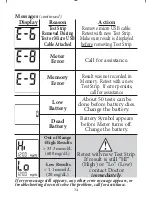
41
REFERENCES
1. Joslin Diabetes Center.
Goals for Blood Glucose Control
[Electronic
Version]. Retrieved February 16, 2012 from
http://www.joslin.org/info/Goals-for-Blood-Glucose-Control.html.
2. FDA Public Health Notification:
Use of Fingerstick Devices on More
than One Person Poses Risk for Transmitting Blood Borne Pathogens:
Initial Communication
Update 11/29/2010 [Electronic Version].
Retrieved February 22, 2012 from http://www.fda.gov/MedicalDevices/
Safety/AlertsandNotices/ucm224025.htm.
3. CDC Clinical Reminder:
Use of Fingerstick Devices on More than one
Person Poses Risk for Transmitting Bloodborne Pathogens
[Electronic
Version]. Retrieved February 22, 2012 from
http://www.cdc.gov/injectionsafety/Fingerstick-DevicesBGM.html.
4. Atkin, S.H., et. al.
Fingerstick Glucose Determination in Shock.
Annals
of Internal Medicine, 114:1020-1024 (1991).
5. Data on file.
6. U.S. Food and Drug Administration.
Blood Glucose Meters, Getting
the Most Out of Your Meter.
[Electronic Version]. Retrieved July
6, 2009: www.fda.gov/MedicalDevices/Safety/ AlertsandNotices/
TipsandArticlesonDeviceSafety/ucm109371.htm.
7. International Organization for Standardization.
In vitro diagnostic
test systems. Requirements for blood-glucose monitoring system
for self-testing in managing diabetes mellitus.
Reference number
ISO 15197:2013 (E). Geneva: International Organization for
Standardization; 2013.
8. Larsson-Cohn
U:
Difference between capillary and venous blood glucose
during oral glucose tolerance tests.
Scand J Clin Lab Invest 36:805-808,
1976.



























